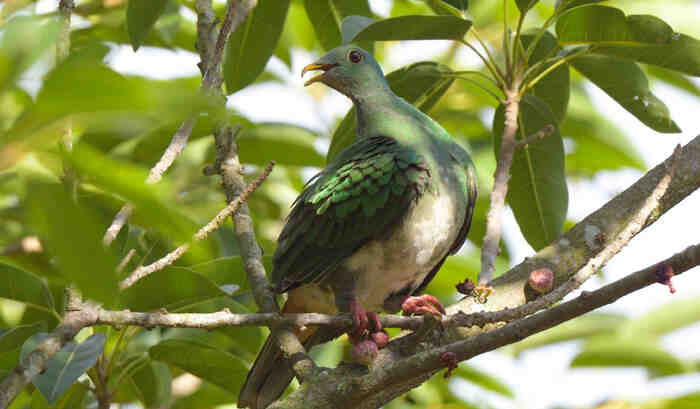Ptilinopus leclancheri
IUCN
LCBasic Information
Scientific classification
- name:Ptilinopus leclancheri
- Scientific Name:Black-chinned Green Pigeon, Little Green Pigeon,Ramphiculus leclancheri,Black-chinned Fruit Dove,Ptilinopus leclancheri
- Outline:Landfowl
- Family:Columbiformes Columbidae F.dove
Vital signs
- length:27-28cm
- Weight:153-157g
- lifetime:About 15 years
Feature
The purple horizontal bands on the chin and chest are the identifying features of this species
Distribution and Habitat
The black-chinned fruit dove is only found in Taiwan Island and the Philippine Islands. China only has the Taiwan subspecies, which is found in Pingtung and Lanyu in southern Taiwan. It is a rare resident bird.
It inhabits tropical rainforests, subtropical forests, mountain broad-leaved forests and mixed forests, and occasionally appears in forest plains.
Appearance
The black-chinned fruit dove is a small bird. The purple horizontal bands on the chin and chest are the identifying features of this species. The forehead, top of the head, front of the eyes, sides of the head, lower throat and chest of the male are light gray. The forehead is chestnut, and the upper throat is black. The occiput, back of the neck and upper back are light gray-green, and the rest of the upper body is emerald green with a metallic luster. Compared with the olive green body feathers of green pigeons, the difference is very obvious, and there is no yellow spot on the wings of green pigeons. The flight feathers are black. The tail feathers are the same color as the back, with light green tips. There are two purple-chestnut horizontal bands on the lower chest. The abdomen is light gray-green, the flanks are green, and the undertail coverts are chestnut. The plumage of the female bird is generally similar to that of the male, but the top of the head, neck and chest are gray-g
Details
Black-chinned Fruit Dove, also known as Black-chinned Fruit Dove, has 4 subspecies.

Black-chinned Fruit Dove is a resident bird, often acting alone, rarely in groups. It is timid and always stops for a while before taking off when in danger. It flies fast and powerfully. They often move in the canopy, especially in the morning and evening, and often live on the dead branches at the top of large trees. They rarely go to the ground, usually only when they need to peck at mud and sand. They forage mostly during the day. They mainly feed on fruits and berries, seeds, buds, leaves, etc. of trees and plants, and also eat insects and small invertebrates.
Black-chinned fruit doves nest on trees in the forest. The nest is flat and very simple, mainly made of dead branches. Each nest lays one egg, which is white and 31-35 mm × 23-25 mm in size. The male and female birds take turns incubating the eggs. The incubation period is 17 days. The chicks are late-maturing and fly away from the nest after 20-35 days.
During the brooding period, pigeons secrete pigeon milk under the action of prolactin (also known as prolactin) secreted by the posterior pituitary gland. Pigeon milk is composed of fat particles, emulsified fat chylomicron and lymph fluid secreted by the proliferating flat epithelium of the bilateral lateral sac lymphatic area of female and male pigeons, that is, the lymphatic area of the crop bed, which is full of fat particles, emulsified fat chylomicron and lymph fluid. After the colostrum period, chylomicron rich in emulsified fat particles is gradually added. The epithelial lymph papilla of the crop bed generally begins to sprout on the 4th to 5th day of the incubation state. The crop bed of male and female pigeons begins to sprout, the blood vessels of the crop bed are congested and thickened, and the lymphatic vessels proliferate. On the 8th to 9th day, the crop epithelium thickens and enters the pre-brooding state. On the 13th day, its thickness and width have doubled. On the 14th-16th day, it can secrete transparent slightly yellow pigeon milk. On the 18th day, the crop can secrete throat milk. However, on the 7th day after the squab hatches, the amount of crop milk secretion begins to decrease, and the secretion stops on the 10th day. It continues to vomit until the chicks are about 2 weeks old, and the crop bed begins to shrink, and the secretion of pigeon milk gradually stops. The semi-finished chyme that is ground by the gizzard and returned from the glandular stomach is gradually mixed into the chyme, and then it becomes a granular feed mixed with water for direct feeding. If the incubated eggs fail to hatch on time, pigeons with good hatching performance can continue to incubate until the 22nd-24th day at most (these are all related to the incubation performance of the pigeon, the hatching season, the feedback of embryonic development information, the frequency of hatching of the embryos, etc. In the cold winter and spring and the brooding period, the incubation period will often be automatically extended, and it is often difficult to persist in the hot and humid days of summer). At this time, the brooding pigeons will automatically stop incubating with the shrinkage of the crop bed.
Listed in the IUCN Red List of Threatened Species in 2016 ver 3.1 - Least Concern (LC).
Listed in China's National List of Key Protected Wildlife (February 5, 2021) Level 2.
Protect wildlife and eliminate game.
Maintaining ecological balance is everyone's responsibility!








